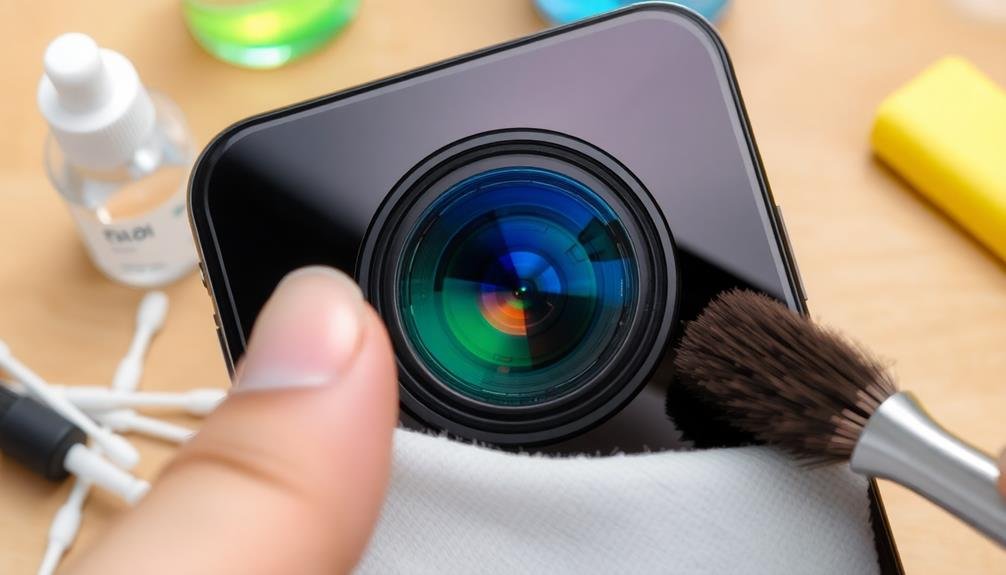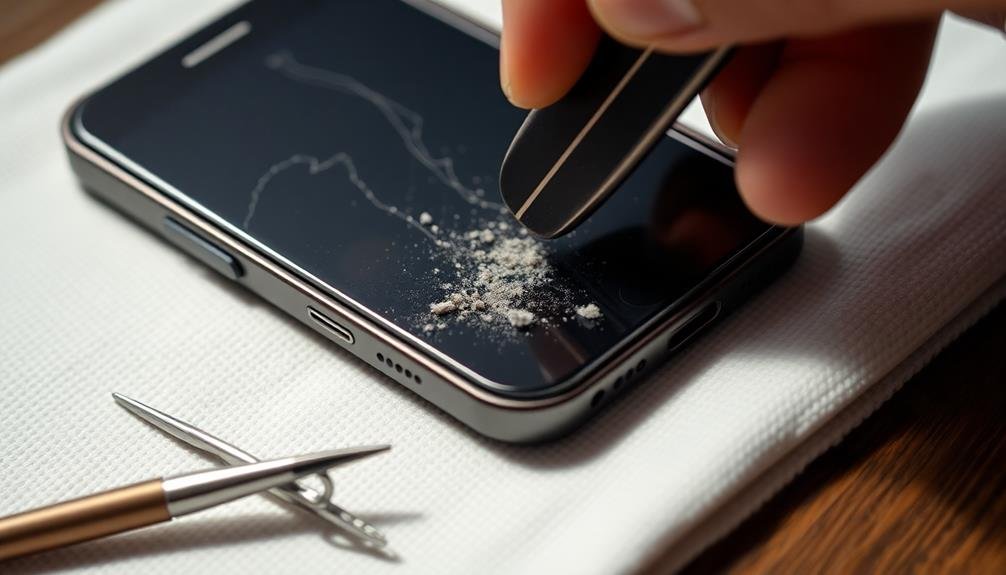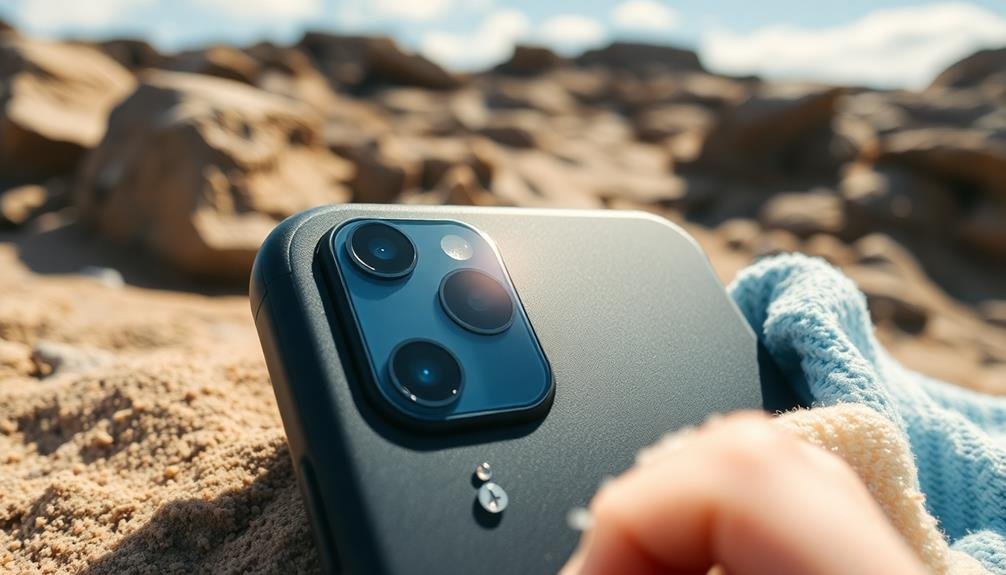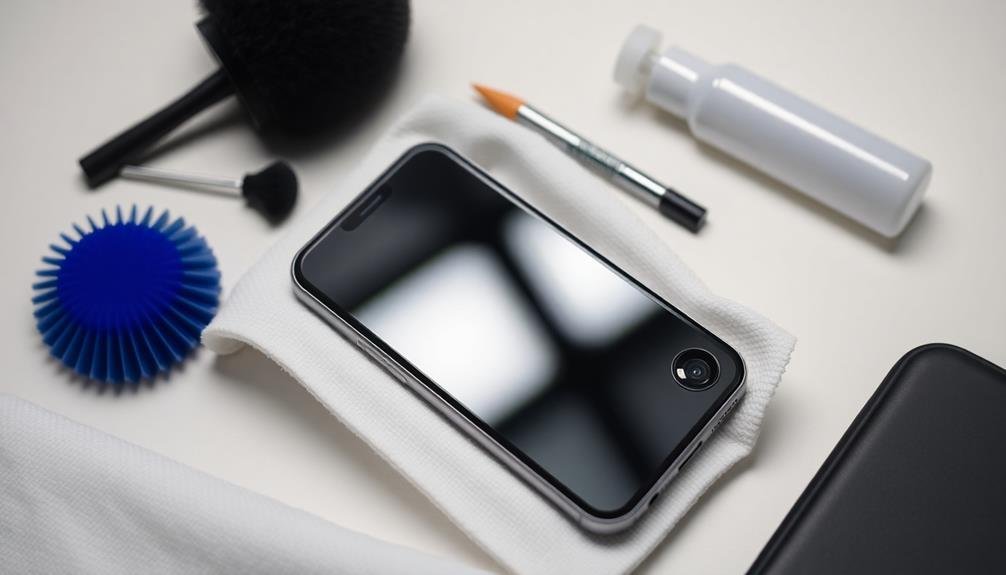Your smartphone camera's care routine should include daily, weekly, and monthly maintenance. Wipe the lens daily with a microfiber cloth to remove fingerprints and dust. Check the sensor weekly for debris and damage. Perform a deep clean monthly, including the lens, surrounding areas, and additional sensors. Update your camera software quarterly for peak performance. Inspect your phone case biannually for wear and tear, and use protective accessories like lens covers. Prevent environmental damage by avoiding extreme temperatures and moisture. For thorough care, consider annual professional servicing. Implementing these practices will help you capture stunning photos for years to come.
Daily Lens Wipe

Your smartphone's camera lens is a magnet for fingerprints, dust, and grime. To guarantee your photos remain crisp and clear, it's crucial to incorporate a daily lens wipe into your routine.
Start by using a microfiber cloth specifically designed for optical surfaces. These cloths are gentle and won't scratch your lens. Avoid using paper towels, tissues, or your shirt, as these can leave scratches or lint behind.
Gently wipe the lens in a circular motion, starting from the center and moving outward. If there's stubborn dirt or smudges, you can slightly dampen the cloth with distilled water or a specialized lens cleaning solution. Be careful not to use too much liquid, as excess moisture can damage your phone.
Don't forget to clean the front-facing camera and any additional lenses your phone may have. If you're in a pinch, you can use your breath to fog up the lens and then wipe it clean, but this should be a last resort.
Make this quick cleaning part of your nightly routine to guarantee your camera's always ready for that perfect shot.
Weekly Sensor Check

Perform a weekly sensor check to maintain your smartphone's camera quality.
Gently remove any dust or debris that may have accumulated on the sensor using a soft brush or compressed air.
Carefully inspect the sensor glass for any scratches or damage, as these can affect image quality and may require professional attention.
Dust and Debris Removal
Dust devils and microscopic debris can wreak havoc on your smartphone's camera sensor. To maintain ideal image quality, it's essential to remove these tiny intruders regularly.
Start by powering off your device and gently wiping the camera lens with a microfiber cloth. For stubborn particles, use a soft-bristled brush designed for camera cleaning.
If you notice persistent spots in your photos, it's time for a more thorough cleaning. Use a specialized lens cleaning solution and apply it sparingly to a microfiber cloth. Gently wipe the lens in a circular motion, being careful not to apply excessive pressure.
For hard-to-reach areas around the lens, try using compressed air in short bursts, holding the can upright to prevent liquid propellant from escaping.
Be cautious when cleaning the camera module, as excessive moisture can damage internal components. If you're uncomfortable performing this maintenance yourself, consider taking your device to a professional.
Sensor Glass Inspection
How often do you inspect your smartphone's camera sensor glass? It's an essential step in maintaining your device's image quality that many users overlook. Performing a weekly sensor check can help you spot issues before they worsen and affect your photos.
To inspect your sensor glass, find a well-lit area and tilt your phone at various angles. Look for any visible scratches, cracks, or smudges on the glass covering your camera lens. If you notice any damage, it's best to consult a professional for repairs.
Don't forget to check for condensation or fogging inside the lens, which could indicate moisture damage. If you see this, power off your device immediately and let it dry in a warm, dry place.
While inspecting, pay attention to any debris stuck around the edges of the sensor glass. Use a soft brush or compressed air to gently remove it. Be cautious not to push debris further into the camera module.
Regular sensor glass inspections will help you maintain your smartphone's camera performance and catch potential problems early, ensuring you're always ready to capture life's moments with clarity.
Monthly Deep Clean

Once a month, your smartphone camera deserves a thorough cleaning to maintain its peak performance. Start by powering off your device and removing any protective cases.
Use a soft, lint-free microfiber cloth to gently wipe the camera lens and surrounding areas. For stubborn smudges, lightly dampen the cloth with distilled water or lens cleaning solution.
Pay special attention to the corners and edges where dirt often accumulates. Use a small, soft-bristled brush or compressed air to remove debris from crevices around the camera module. Be careful not to let any moisture enter the phone's openings.
Clean the flash and any additional sensors with the same care. If your phone has a periscope zoom lens, verify it's free from dust and fingerprints. For phones with multiple camera lenses, clean each one individually.
Inspect the camera bump and gently clean it, as it often collects dust.
Quarterly Software Updates

Software updates are essential for maintaining your smartphone camera's functionality and performance. Every quarter, you should check for and install the latest updates for your device's operating system and camera app.
These updates often include bug fixes, security patches, and new features that can enhance your photography experience.
To guarantee you're getting the most out of your smartphone camera, follow these steps:
- Enable automatic updates: Go to your device's settings and turn on automatic updates for both the operating system and apps. This way, you'll always have the latest improvements without having to remember to check manually.
- Read update notes: When a new update is available, take a moment to read through the release notes. They'll inform you about new camera features, improvements, and any changes you should be aware of.
- Clear cache after updates: After installing updates, clear your camera app's cache to guarantee smooth performance and prevent potential glitches.
Biannual Case Inspection

Inspect your smartphone case twice a year for signs of wear and tear.
Look for cracks, loose edges, or discoloration that could compromise protection.
Clean the case thoroughly, removing it from your device to guarantee you address all areas where dust and debris may accumulate.
Check for Wear Signs
A crucial part of your smartphone camera maintenance is the biannual case inspection. During this check, you'll want to look for signs of wear that could potentially impact your camera's performance or protection. Pay close attention to the areas around the camera lens and flash, as these are often the most vulnerable spots.
When examining your phone case for wear signs, focus on these key areas:
- Edges and corners: Look for fraying, cracks, or chips that might compromise the case's ability to absorb shock.
- Camera cutout: Check for any expansion or deformation that could expose the lens to dust or damage.
- Button covers: Verify they're still responsive and haven't worn thin or developed holes.
If you notice any of these issues, it's time to think about replacing your case. Remember, a worn-out case can't effectively protect your device or its camera.
Don't overlook scratches on the case itself, as they can indicate that it's absorbed impact that might've otherwise damaged your phone.
Clean Case Thoroughly
Once you've checked for wear signs, it's time to give your phone case a thorough cleaning. Remove your phone from the case and inspect it for dirt, grime, or debris that may have accumulated over time. Pay special attention to corners and crevices where dust and lint often collect.
For plastic or silicone cases, use a mixture of warm water and mild dish soap. Gently scrub the case with a soft-bristled toothbrush, focusing on problem areas. Rinse thoroughly and dry with a lint-free cloth.
For leather cases, use a specialized leather cleaner and follow the manufacturer's instructions.
Don't forget to clean the inside of the case as well. Use a slightly damp microfiber cloth to wipe down the interior, removing any dirt or particles that could potentially scratch your phone. For stubborn stains, try using a cotton swab dipped in isopropyl alcohol, but be cautious not to oversaturate the material.
Once clean, allow the case to air dry completely before reattaching it to your phone. This biannual deep cleaning helps maintain your case's appearance and guarantees it continues to protect your device effectively.
Yearly Professional Servicing

While regular maintenance can keep your smartphone camera in good shape, entrusting it to a professional once a year can guarantee peak performance.
A certified technician can perform a detailed inspection and cleaning that goes beyond what you can do at home. They'll check for internal issues, clean hard-to-reach areas, and verify all components are functioning at their best.
During your yearly professional servicing, the technician will typically:
- Conduct a thorough diagnostic test to identify any hidden problems
- Clean the camera lens and sensor using specialized equipment
- Update firmware and software to improve functionality and security
Protective Accessories Usage

In addition to regular maintenance, using protective accessories can greatly extend your smartphone camera's lifespan and performance.
Invest in a high-quality phone case that offers specific protection for your camera lens. Look for cases with raised edges around the camera module to prevent direct contact with surfaces when you set your phone down.
Consider applying a tempered glass screen protector that covers both your display and camera lenses. These protectors shield against scratches, dust, and minor impacts.
For added protection, use lens covers or stickers when you're not actively using your camera.
When carrying your phone, avoid placing it in pockets with keys, coins, or other abrasive objects. Instead, use a dedicated phone pouch or compartment in your bag.
If you're heading to dusty or sandy environments, bring a waterproof phone case to shield your device from particles.
Don't forget about protecting your camera during extreme weather conditions. Use insulated cases in cold temperatures and avoid sudden temperature changes that can cause condensation on your lens.
In hot climates, keep your phone out of direct sunlight to prevent overheating and potential damage to the camera sensors.
Environmental Damage Prevention

Environmental factors pose a considerable threat to your smartphone's camera. To protect your device from potential harm, you'll need to be mindful of various conditions that can impact its performance and longevity. Extreme temperatures, humidity, and physical elements like sand or dust can all wreak havoc on your camera's delicate components.
To prevent environmental damage, follow these key steps:
- Avoid exposing your phone to direct sunlight for extended periods, as excessive heat can damage the camera sensor and lens.
- Keep your device away from moisture-rich environments, such as bathrooms during hot showers or saunas, to prevent condensation buildup.
- Use a protective case with integrated lens covers when in dusty or sandy areas to shield your camera from abrasive particles.
When moving between different temperature zones, allow your phone to gradually acclimate to prevent fogging or condensation on the lens.
If you're heading to the beach or pool, consider using a waterproof case for added protection against splashes and accidental submersion.
Frequently Asked Questions
How Often Should I Replace My Smartphone Camera's Lens?
You don't typically need to replace your smartphone camera's lens. It's built to last the life of your device. However, if you notice scratches or damage affecting image quality, consider professional repair or upgrading your phone.
Can I Use Household Cleaners on My Smartphone Camera?
No, don't use household cleaners on your smartphone camera. They can damage the lens coating and internal components. Instead, use a microfiber cloth or specialized electronic cleaning wipes. For stubborn smudges, lightly dampen the cloth with distilled water.
What's the Best Way to Clean the Camera Bump?
To clean your camera bump, use a soft microfiber cloth slightly dampened with distilled water. Gently wipe the area, avoiding excess moisture. For stubborn dirt, try a small amount of isopropyl alcohol on the cloth. Don't forget to dry thoroughly.
How Do I Prevent Condensation in My Smartphone Camera?
To prevent condensation in your smartphone camera, avoid sudden temperature changes. Keep your phone in a case or bag when moving between environments. Use silica gel packets near your device, and don't leave it in humid places overnight.
Should I Disable Camera Features to Extend Its Lifespan?
You don't need to disable camera features to extend its lifespan. Instead, focus on proper care: keep it clean, avoid extreme temperatures, and use it responsibly. Regular software updates can also help maintain peak performance without sacrificing functionality.
In Summary
Your smartphone camera's care routine doesn't have to be complicated. By following these simple steps, you'll keep your camera in top shape. Remember to wipe your lens daily, check the sensor weekly, and deep clean monthly. Don't forget quarterly software updates and biannual case inspections. Invest in protective accessories and shield your device from environmental damage. With a yearly professional service, you're ensuring your smartphone camera stays sharp and ready to capture life's moments.





Leave a Reply